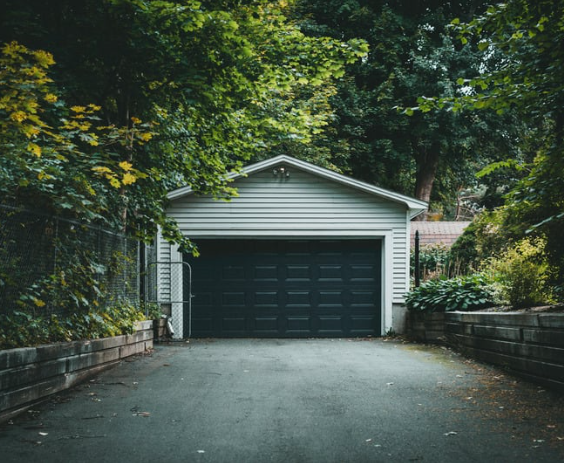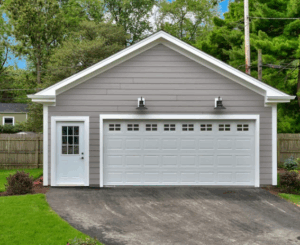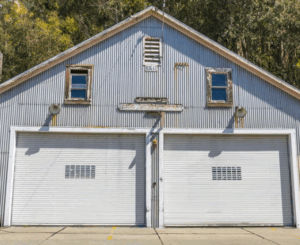Discover the ideal width for a single garage door and how it affects functionality and convenience. Learn about different sizes and factors to consider when choosing the right garage door for your home.
When planning or upgrading your garage, one key question arises: How wide is a single garage door? The answer goes beyond aesthetics, affecting vehicle accessibility, storage space, and overall functionality. Understanding garage door dimensions is essential whether you’re renovating, replacing an old door, or building from scratch. Proper measurements are vital.
Choosing the correct garage door size is crucial for long-term performance. Standard widths may suffice, but there are times when custom sizes are necessary for optimal fit. Accurate measurements are essential for avoiding costly mistakes. If you need help with fixing a garage door that is off track or selecting the right size, Perfect Solutions Garage Door can assist with expert advice and installation.
Standard Dimensions of a Single Garage Door
A standard single garage door typically measures 8 to 10 feet wide and 7 to 8 feet high. Among these, the most common configuration is 9 feet wide by 7 feet high. This size accommodates most sedans, crossovers, and smaller SUVs with comfortable clearance on either side.
These standard sizes are cost-effective, readily available, and easy to install without requiring structural modifications. They’re particularly well-suited for homes with average driveway widths and standard garage layouts.
When to Consider Custom Widths
There are instances where standard dimensions may fall short. Homeowners with oversized vehicles such as lifted trucks, work vans, or SUVs with cargo attachments may find the typical 9-foot opening too narrow. In these cases, custom widths ranging from 7 feet to 10.5 feet may offer a better fit.
Additionally, garages that serve dual purposes—like housing a golf cart or storing large equipment—benefit from broader openings. Custom sizing ensures your garage entry aligns with your unique layout and needs, providing both functionality and long-term value.
Essential Clearance Measurements You Must Know
The width of a garage door is only part of the equation. Proper installation also requires:
- Side room: At least 3.5 to 5 inches on each side for track installation
- Headroom: Minimum 10 to 12 inches above the opening to fit the door and track mechanism
- Backroom: Clearance from the garage door to the back wall, generally 18 inches or more beyond the door height
Failing to account for these dimensions can cause operational issues and reduce the effectiveness of insulation and security systems.
Single vs. Double Garage Doors: Which is Better for You?
Choosing between a single and double garage door depends on lifestyle and layout. A single door is ideal for homeowners with limited space or those who prefer a partitioned approach to vehicle storage. It’s often more energy-efficient since it opens a smaller area, minimizing heat loss.
By contrast, a double door—usually 16 feet wide—offers a seamless look and easy access for two cars parked side by side. However, in smaller properties or narrow driveways, single doors may be more practical and cost-effective.
| Feature | Single Garage Door | Double Garage Door |
| Width | 8-10 ft | 16 ft |
| Energy Efficiency | Higher | Lower |
| Access Points | Individual | Unified |
| Replacement Cost | Lower | Higher |
Different Garage Door Types and How Sizes Vary
When choosing the right garage door, the type of door you select plays a key role in determining the necessary width. Here’s a breakdown of how different styles affect your garage space:
- Roll-Up Doors: Perfect for smaller garages with limited ceiling space. These doors usually fit well in standard 8–9 ft widths, offering a compact solution.
- Sectional Doors: The most common type, sectional doors are versatile and can accommodate both standard and custom widths, making them an excellent fit for most garages.
- Carriage-Style Doors: Known for their swing-out design, carriage-style doors are typically wider and require more space on either side for whole operation.
- Tilt-Up Doors: Best suited for wide openings, these doors require more overhead clearance but are ideal for larger garages.
Your choice should align with your garage’s layout and functional needs, particularly when considering tight clearances or the desire for added insulation. Each style offers distinct benefits, tailored to specific spaces and usage.
How to Measure Your Garage Door Opening: DIY Tips
When choosing the right garage door, the type of door you select plays a key role in determining the necessary width. Here’s a breakdown of how different styles affect your garage space:
- Roll-Up Doors: Perfect for smaller garages with limited ceiling space. These doors usually fit well in standard 8–9 ft widths, offering a compact solution.
- Sectional Doors: The most common type, sectional doors are versatile and can accommodate both standard and custom widths, making them a great fit for most garages.
- Carriage-Style Doors: Known for their swing-out design, carriage-style doors are typically wider and require more side room for full operation.
- Tilt-Up Doors: Best suited for wide openings, these doors require more overhead clearance but are ideal for larger garages.
Your choice should align with your garage’s layout and functional needs, particularly when considering tight clearances or the desire for added insulation. Each style offers distinct benefits based on space and usage.
Common Mistakes to Avoid with Garage Door Sizing
When it comes to garage door sizing, avoiding common mistakes can save you time, money, and frustration. Here are a few key things to keep in mind:
- Assuming one-size-fits-all: Not all garage doors are the same. Be sure to measure each opening accurately before purchasing a new door. One size doesn’t fit all, and a proper fit is crucial for smooth operation.
- Overlooking headroom: If there’s not enough headroom, certain garage door opener systems won’t fit properly. Make sure to leave ample space above the door for installation.
- Ignoring vehicle dimensions: Your garage door needs to accommodate not just the door but your vehicles. Measure your vehicle’s width, height, and clearance needs to ensure a comfortable fit.
- Skipping clearance checks: Don’t forget to account for any trim, track, or opener hardware that might affect the space needed for smooth operation.
By paying attention to these factors, you can avoid installation delays and unnecessary costs.
FAQ: Common Questions About Garage Door Widths
How Wide Should a Garage Door Be for One Car?
A standard single garage door should ideally be 9 feet wide, offering enough room for most sedans and small SUVs. Garage door widths typically range from 8 to 10 feet, with 9 feet being the most common choice for convenience, functionality, and modern garage door design compatibility.
Can a Truck Fit in a Single Garage Door?
Yes, but it depends on the truck’s size and the garage door’s width. Full-size trucks generally need at least a 9-foot or 10-foot wide garage door to fit comfortably without scraping mirrors or fenders. Always measure your truck and garage opening before choosing a garage door size.
What’s the Narrowest Single Garage Door Available?
The narrowest standard single garage door is typically 7 feet wide. These doors are usually installed in older homes or for compact garages. While they work for small vehicles, a 7-foot garage door is less common today due to the increasing size of modern cars and driver preferences.
Can You Convert a Single Garage Door to a Double?
Yes, you can convert a single garage door into a double, but it requires professional structural modifications. A contractor must remove the center support post and install a reinforced header to maintain the garage’s structural integrity. This upgrade boosts functionality and enhances curb appeal, especially for multi-vehicle households.
Do Garage Door Sizes Affect Home Resale Value?
Absolutely. Correctly sized garage doors improve usability and enhance a home’s curb appeal, making a significant impact on resale value. Buyers often favor homes with spacious, accessible garages. Choosing the right garage door size can make your home more attractive and competitive in a crowded real estate market.
Conclusion: Size Matters—So Does the Right Fit
Choosing the right garage door width is essential for enhancing functionality, safety, and overall convenience. Proper sizing ensures smooth access and minimizes wear and tear, contributing to long-term performance. It’s a key factor in maintaining a secure and efficient home environment, ultimately boosting your property’s value and keeping your garage in optimal condition.
If you’re unsure about the best garage door width for your needs, it’s wise to consult a professional. An expert can assess your specific space, vehicle sizes, and daily usage to provide tailored advice, ensuring you select the ideal door size. Expert guidance guarantees a perfect fit for your garage, avoiding costly mistakes.
End Note
Perfect Solutions Garage Door is dedicated to offering top-notch garage door services for all your needs. Whether you’re looking for expert advice on choosing the right door or seeking installation, our team ensures a seamless experience from start to finish. Check out our full range of services at Perfect Solutions Garage Door and explore our gallery for inspiration. We also provide quality products like Amarr doors and LiftMaster openers for lasting performance, available on our Amarr and LiftMaster pages.
Want to learn more or have any questions? Visit our about us page to discover who we are, and don’t hesitate to reach out through our contact us page. For the latest updates and expert advice, follow us on Facebook and check out our insightful blog. Serving a wide range of areas, you can also find more information on our service areas.





